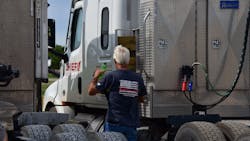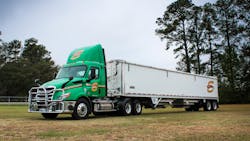Fleets find success building driver-centric culture
Recruiting and retaining professional drivers remains a top priority for commercial fleet owners and managers. While creating a driver-centric company culture can be challenging, communication and transparency tend to be the silver bullets for the fleets that have found success.
As a former truck driver and dispatcher, Andrew Winkler, now general manager at Chief Carriers, which runs 65 trucks and 200 flatbed trailers and is a subsidiary of Chief Industries, is well aware that communication is essential when it comes to improving and maintaining a quality workplace and environment for drivers.
“You have to constantly listen to the drivers,” Winkler told FleetOwner. “If you just have a conversation with them, you’ll start to understand and learn what’s important to them.”
Winkler got his start in the industry in 1995 as a student driver for Grand Island Express (GIE). After earning his commercial driver’s license, he drove over the road for GIE for about 10 months before accepting a position as a dispatcher. Throughout his career at GIE, Winkler progressed from student driver to solo driver, from dispatcher to operations manager, and then safety director before eventually leaving the company as vice president of operations. He took on the role of general manager at Chief Carriers in 2018.
“I think being a former driver has helped a lot not only with perspective and experience on the road, but they certainly respect you if you came up through the system after starting as a driver,” Winkler explained.
For Scott Manthey, vice president of safety and training at Wilson Logistics, a transportation logistics company based in Springfield, Mo., making Wilson a better company for drivers topped his to-do list when he started the job three years ago. Before Wilson, Manthey worked for Gordon Trucking and Interstate Distributor (both now owned by Heartland Express).
Back in 2007 when Manthey was with Gordon Trucking, he got involved with the Truckload Carriers Association and CarriersEdge and was introduced to their Best Fleets to Drive For program.
“We’ve put a lot of focus on listening and trying to be respectful,” Manthey explained. “We’ve been pushing getting to know drivers. Fleet managers know which drivers need to get home for what family event and when. If they let us know they need something, then we try to accommodate them.”
Since the Best Fleets to Drive For program’s founding in 2009, Winkler and Manthey have been the only two fleet professionals to have transformed multiple fleets into Top 20 winners. Winkler had previously assisted in forming a company culture at GIE that consistently ranks among the best fleets. Since 2012, GIE has been named a Best Fleet to Drive For each year. Manthey’s work with Gordon Trucking, Interstate Distributor, and Wilson Logistics helped them become a Best Fleet to Drive For several times.
According to Manthey, to better understand how the company can best accommodate or improve working conditions for its drivers, Wilson Logistics provides special training for fleet managers and all employees.
“Our belief is that everybody is created equal. We just have different strengths and weaknesses,” he explained. “I think about what type of environment I would want my kids working in and apply that thought when making decisions. The owner of the company is no different than anyone else. We’re all human beings and have the same basic needs in life. Once you establish and maintain good communications across divisions, creating a healthy work environment becomes easier.”
Culture, safety, and retention
To improve Wilson's culture within the fleet, Manthey pulled information from Best Fleets surveys and noticed there were some significant gaps in home time, communication, and what amenities were available to drivers across the business that he felt could be filled quickly.
“There was a lot of work to do; it doesn’t happen overnight," Manthey explained. "When you’re talking about shifting culture, it takes time. This past year, we fine-tuned things and recreated the job to give drivers more regional options.
“We actually look at where we hire people,” he continued. “There’s a driver shortage and it’s tough, but the last thing we want to do is hire somebody and then they’re never able to go home because they’re just going to leave.”
Chief Carrier’s Winkler first heard about the Best Fleets program when he was working at Grand Island Express. Over the course of the first year of the program, he learned that the company had good driver programs in place, but that communication with drivers needed improvement.
Since joining Chief Carriers in 2018, Winkler relied on his experience participating with the Best Fleets program and helped his new company build better communication practices with its drivers. The company uses Facebook, videos, and other communication channels to maintain relationships with drivers and keep them informed.
“It’s been our biggest improvement since I joined Chief Carriers,” said Winkler. “It’s important to be transparent with drivers. It helps build trust. Once you have that down, it’s easier to focus on other areas that can better the workplace.”
The past year has been challenging for many fleets’ retention efforts because of drivers prematurely leaving the industry due to COVID-19 and regulatory measures, like the Drug & Alcohol Clearinghouse. For Catherine Ezzell, president of Ezzell Trucking, the coronavirus pandemic prompted many communication challenges for the smaller bulk wood residual hauler, which prides itself on getting to know all its drivers on a personal level.
“With COVID, we weren’t able to make as many on-site visits as we would otherwise,” Ezzell said. “We try to do those in-person meetings and face-to-face talks, and COVID put a stop to that—at least in the short term.”
In late 2020, the carrier reached out to WorkHound to help enhance communication with drivers. The company has since found success utilizing WorkHound’s feedback app to send out driver surveys as well as alerts from management so drivers know immediately of any pay changes or company-wide concerns.
“We can’t get better unless we know what we need to improve on," Ezzell said. "It has been a wonderful way to hear from our folks. One of the quickest things that we were able to turn around based on feedback is driver waiting time. We know that a driver’s time is valuable. Based on our folks’ feedback, we were able to improve our waiting time pay structure in case a driver gets detained at a customer site.”
In addition to leveraging feedback and data from WorkHound, Ezzell Trucking has spec’d its trucks with safety features like anti-rollover, collision avoidance, lane departure, cameras, and in-cab recording devices to improve overall safety and operations.
“More drivers have thanked us for installing them,” Ezzell told FleetOwner. “That shows the quality of the driver we bring onboard. Our hiring standards are very strict as far as a driver’s past safety record. In fact, over the past five years, we have never had a year where our number of perfectly clean motor vehicle records for all our drivers has dipped below 98%.”
On the technology front, Wilson Logistics also runs various safety features and forward-facing cameras. Wilson also uses critical event recording (CER) devices to coach drivers.
“We turned on CER about two years ago, and it was very surprising,” Manthey said. “We did some coaching with the fleet managers and drivers, and we have shaved off events by more than two-thirds.”
Addressing driver concerns and expectations
Although compensation is a consistent concern for drivers, over the last several years, Winkler has seen a trend where home time has become just as important, if not more important, than the money itself.
“When you talk to a lot of drivers, they might inquire about your company and one of the first things they ask is how often do I get home, or what does the home time look like? Maybe even before they ask what it pays,” he said.
Manthey also agreed that compensation has always been a major concern for drivers, but more recently, transparency has become incredibly important for driver morale.
“We find it’s more about the quality of life, home time, and respect,” he noted.
During the pandemic, Wilson Logistics made it a point that no company employee went without a paycheck if they had to miss work. The carrier also paid drivers their five-week average if they had to take time off because of the virus. Overall, the company spent $1.7 million between salaries, COVID-19 tests, and time off over a 14-month period during the pandemic.
Chief Carriers has also put a great deal of emphasis on respect and transparency. And according to Winkler, that commitment to transparency has led to trust and driver retention.
“At the end of the day, we are just creating a place where drivers want to be,” he explained. “We all know it’s gotten super competitive, especially in the last few months. You really have to look in the mirror and ask yourself what you can do internally to create a place where professional drivers want to be.”
To identify programs within their company that could be improved and best position themselves to remain a top workplace in the industry, Winkler and Manthey said they pay close attention to the results booklet that is published by the Best Fleets program at the conclusion of the competition each year.
“Everyone within the Best Fleet community essentially learns from each other,” Winkler said. “And it doesn’t mean that you take every great idea that comes out, but you take those ideas and ask yourself, ‘How can we make this work within our organization?’ I think that’s how we made the biggest gains—just by studying programs and looking at what our fellow fleets are doing.”
About the Author

Cristina Commendatore
Cristina Commendatore is a past FleetOwner editor-in-chief. She wrote for the publication from 2015 to 2023.

